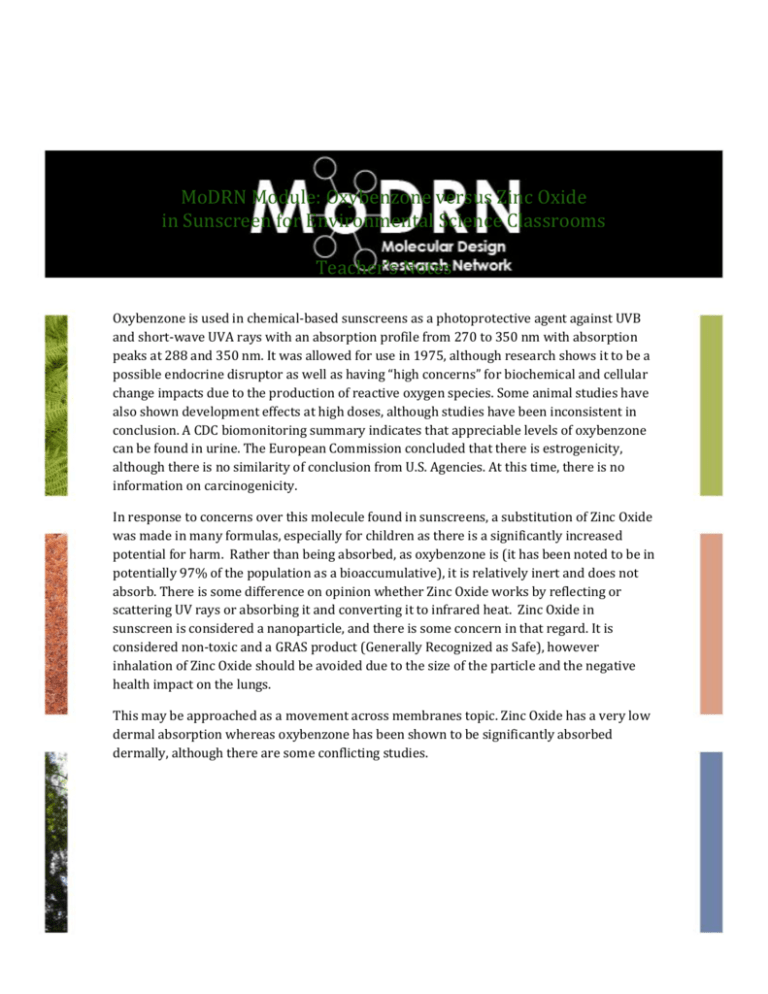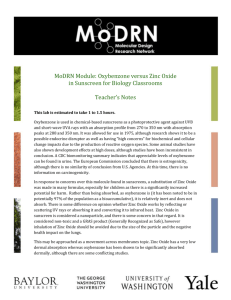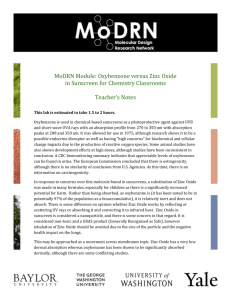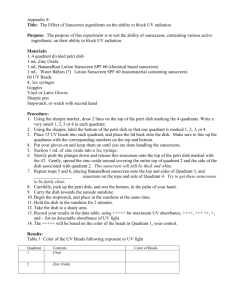WORD - Molecular Design Research Network (MoDRN)
advertisement

MoDRN Module: Oxybenzone versus Zinc Oxide in Sunscreen for Environmental Science Classrooms Teacher’s Notes Oxybenzone is used in chemical-based sunscreens as a photoprotective agent against UVB and short-wave UVA rays with an absorption profile from 270 to 350 nm with absorption peaks at 288 and 350 nm. It was allowed for use in 1975, although research shows it to be a possible endocrine disruptor as well as having “high concerns” for biochemical and cellular change impacts due to the production of reactive oxygen species. Some animal studies have also shown development effects at high doses, although studies have been inconsistent in conclusion. A CDC biomonitoring summary indicates that appreciable levels of oxybenzone can be found in urine. The European Commission concluded that there is estrogenicity, although there is no similarity of conclusion from U.S. Agencies. At this time, there is no information on carcinogenicity. In response to concerns over this molecule found in sunscreens, a substitution of Zinc Oxide was made in many formulas, especially for children as there is a significantly increased potential for harm. Rather than being absorbed, as oxybenzone is (it has been noted to be in potentially 97% of the population as a bioaccumulative), it is relatively inert and does not absorb. There is some difference on opinion whether Zinc Oxide works by reflecting or scattering UV rays or absorbing it and converting it to infrared heat. Zinc Oxide in sunscreen is considered a nanoparticle, and there is some concern in that regard. It is considered non-toxic and a GRAS product (Generally Recognized as Safe), however inhalation of Zinc Oxide should be avoided due to the size of the particle and the negative health impact on the lungs. This may be approached as a movement across membranes topic. Zinc Oxide has a very low dermal absorption whereas oxybenzone has been shown to be significantly absorbed dermally, although there are some conflicting studies. The chemistry classroom module aligns to the following Next Generation Science Standard: HS-PS2-6. Communicate scientific and technical information about why the molecular-level structure is important in the functioning of designed materials. The biology classroom module aligns to the following Next Generation Science Standard: HS-ETS1-2. Design a solution to a complex real-world problem by breaking it down into smaller, more manageable problems that can be solved through engineering. The environmental science classroom module aligns to the following Next Generation Science Standard: HS-LS4-6. Create or revise a simulation to test a solution to mitigate adverse impacts of human activity on biodiversity. NOTE: The experiment for the environmental science classroom can be adapted uses other organisms or seeds. Laboratory Preparation Helpful Information For this lab, you may wish to either have students make their own dilutions of the stock solutions on their own or provide them for the student. For a class of 24, a 500ml stock solution is enough for each sunscreen. Dahpnia are very delicate and do not tolerate high concentrations of chemicals. It is suggested that your stock solution be 1% and then dilute down from there. Review the equation %1V1 = %2V2 for dilutions. The best way to measure volume of an undiluted sunscreen is to squirt the sunscreen into a large syringe and measure mL that way. Zinc oxide does not readily go into solution. Therefore, it is suggested that you only use oxybenzone-based products. Finally, please provide overview of the Daphnia organism, including which structure is its beating heart versus its abdomen. A picture is helpful for students to identify the anatomy. Supplemental Readings The following are supplemental readings for you and your students to understand the general principles of green chemistry as well as the role of molecule substitution in toxicity consideration: CDC. (2013). Oxybenzone: Biomonitoring Summary. Retrieved from http://www.cdc.gov/biomonitoring/Benzophenone-3_BiomonitoringSummary.html European Commission. (2001). Opinion on the Evaluation of Potentially Estrogenic Effects of UV-filters adopted by the SCCNFP during the 17th Plenary meeting of 12 June 2001. Retrieved from http://ec.europa.eu/health/scientific_committees/consumer_safety/opinions/sccnfp_opini ons_97_04/sccp_out145_en.htm European Commission. (2006). Opinion on Benzophenone-3. Retrieved from http://ec.europa.eu/health/ph_risk/committees/04_sccp/docs/sccp_o_078.pdf Environmental Working Group. (2014). Oxybenzone. Retrieved from http://www.ewg.org/skindeep/ingredient/704372/OXYBENZONE/# NCBI. (n.d.). PubChem compound: Oxybenzone. Retrieved from http://pubchem.ncbi.nlm.nih.gov/summary/summary.cgi?cid=4632 The Organisation for Economic Co-operation and Development. (2004). OECD guidelines for the testing of chemicals, Section 2: Test No. 202: Daphnia sp. acute immobilisation test. Retrieved from http://www.oecd-ilibrary.org/environment/test-no-202-daphnia-sp-acuteimmobilisation-test_9789264069947-en Background What is UV? UV is ultraviolet light, a light wave shorter than violet-color light. UV light is divided into 3 wave-lengths: UV-A, the most common; UV-B, the most dangerous; and UV-C , is dangerous but we’re not exposed because it is bounced back to space by the Earth’s ozone layer. THE LIGHT SPECTRUM Infrared Visible UV-A UV-B UV-C 1000-700nm* 390-700nm* 400-315nm* 315-280nm* 280-100nm* Makes our skin feel warm. Can be seen by snakes Wavelength seen by our eyes. Includes the colors of the visible spectrum Invisible. Shorter wavelengths, more energy. Causes skin damage, premature aging, melanoma. Passes through car glass Causes sunburn, skin cancer, photo-aging, cataracts. Needed for Vitamin D synthesis Dangerous, but completely absorbed by the ozone layer and doesn’t reach earth surface What does Exposure mean? Exposure happens when UV radiation from the sun reaches your skin. You are exposed to UV when you are outside on sunny or cloudy days. UV intensity varies with time of day, season, and latitude. The equator at noon receives much more UV than at noon in Norway. You can still get sunburned on cloudy days because UV rays can bounce off the clouds. This is known as the broken-cloud effect. In fact, one survey found that UV-B increased by 25% on party cloudy compared to sunny days. Risks & Benefits of UV Exposure UV is an environmental carcinogen, which means that being exposed to UV light can cause cancer. Unprotected UV exposure causes skin damage, speeds aging and increases lifetime risk of skin cancer. Sun exposure also causes wrinkles, brown spots, leathering and sagging. There is no such thing as a healthy tan. Any change in your skin color is a sign of skin damage. 1.3 million people are diagnosed with skin cancer in the US each year, mostly from sun exposure. UV is harmful for anyone, but those with fair skin are at higher risk because they burn more quickly and severely. More Americans have skin cancer than all other cancers combined. The only benefit of UV exposure is Vitamin D. Five minutes of unprotected UV 2-3 times a week provides all the Vitamin D the body can make. Some UV reaches the skin even when you wear sunscreen. What is SPF? SPF stands for Sun Protection Factor. SPF is the fraction of UV-B rays blocked by the sunscreen. In SPF15, 1/15th of the UV-B rays will reach the skin when sunscreen is applied properly. If you get sunburned in 10 minutes without sunscreen, you will prevent sunburn for 150 minutes by wearing an SPF15 sunscreen. SPF15 sunscreen protects from 93% of UV-B, SPF30 protects from 97%, and SPF50 gives 98% protection. The Food and Drug Administration (FDA), which regulates sunscreens as an over-the-counter drug, does not recommend using sunscreen with SPF higher than 50. FDA says sunscreen higher than SPF50 is misleading because it offers little added protection, gives a false sense of safety, and tempts people to reapply less often or stay in the sun longer. What about nanoparticles in sunscreen? Nanoparticles are ultra-fine particles between 1-100 nanometers in diameter. Nano-size titanium dioxide and zinc oxide have been used in some sunscreens since the 1990s. These physical ingredients reflect, scatter and absorb UV rays and don’t tend to cause allergic reactions. The nano-size particles are clear, while older sunscreens used larger particles that appeared white on the skin. Nanoparticles do not pass through healthy skin. Sunscreen with nano-particles protects skin as soon as it is applied while conventional sunscreens must be absorbed. Risks & Benefits of Using Sunscreen Sunscreens are more protective against UV-B than UV-A. Avobenzone, titanium dioxide and zinc oxide protect against UV-A. New products that protect against UV-A are used in Europe and are under review by the FDA. Spray sunscreen should not be inhaled, especially sunscreen with nanoparticles because the small particles can be harmful to the lungs. Oxybenzone in sunscreen can penetrate the skin and cause an allergic reaction. It can also interfere with normal hormone function. Sunscreen SPFs higher than 50 have higher concentrations of chemicals and are more likely to have these effects. However, any sunscreen is better for you than being exposed to UV radiation. How Can I Protect Myself? Stay out of the sun between 10am-4pm Stay in the shade Wear protective clothing Use a “broad spectrum” sunscreen with SPF30-50 to protect from both UV-A and UV-B Avoid getting sunburned Apply sunscreen thickly, 1 oz. every 2 hours Apply conventional sunscreen 20 min. before going in the sun, giving it time to absorb into your skin Don’t use indoor tanning beds. Exposure to tanning beds before age 30 increases the risk of developing melanoma by 75% With less mature skin and higher surface area to body weight, babies should not be exposed to UV or sunscreen. Babies under 6 mo should be covered and kept out of the sun, especially from 10am-4pm Student Laboratory Experiment: Daphnia as a Model for Sunscreen Toxicity Student Learning Objectives At the end of this lesson, students will be able to: Develop a testable hypothesis. Design a test for toxicity of sunscreen. Identify independent and dependent variables. Gather data in support of the hypothesis testing. Use a microscope to make observations of Daphnia organisms. Conclude basic concepts of toxicology based on interpretation of data through hypothesis testing. Lab Safety Always remember to follow the posted lab safety and waste disposal instructions. Please visit the American Chemical Society for Safety Guidelines. http://www.acs.org/content/acs/en/education/policies/safety.html Real World Application The choices we make can impact many systems, including environmental ones and those living things within. It is important to understand how to test for toxicity in order to consider the safety of products that we use each and every day. Sometimes there is no “right” answer, just various shades of “better.” We face this issue every day when designing new chemicals and products for use. Pre-Lab Questions What is an experimental variable? What is an independent variable? How are they related? _________________________________________________________________________________________________________ _________________________________________________________________________________________________________ _________________________________________________________________________________________________________ _________________________________________________________________________________________________________ What are control variables and do they have any impact on an experiment? Why or why not? _________________________________________________________________________________________________________ _________________________________________________________________________________________________________ _________________________________________________________________________________________________________ _________________________________________________________________________________________________________ Which of the following is a valid hypothesis statement? Why is the other one NOT valid? 1. Zinc oxide may be less toxic than oxybenzone to the Daphnia genus. 2. Zinc oxide is less toxic than oxybenzone to the Daphnia genus. _________________________________________________________________________________________________________ _________________________________________________________________________________________________________ _________________________________________________________________________________________________________ _________________________________________________________________________________________________________ Why is it important to make sure to repeat your experiments? _________________________________________________________________________________________________________ _________________________________________________________________________________________________________ _________________________________________________________________________________________________________ _________________________________________________________________________________________________________ What are Daphnia and why are they a good organism for researching toxicity? _________________________________________________________________________________________________________ _________________________________________________________________________________________________________ _________________________________________________________________________________________________________ _________________________________________________________________________________________________________ Materials Living Daphnia organisms Pipettes Microscope Petri dishes Depression Microscope slides Various SPFs of sunscreens or various brands: SPF 15, SPF 30, SPF 50, and a lotion with no active ingredients as a control Spring or Pond Water (note: Daphnia do not survive in distilled water) Beakers and graduated cylinders Large syringes for creating dilutions Other materials as needed Method and Instructions For this lab, you (as a group or individually, as assigned by your teacher) will develop and test a protocol to test toxicity of zinc oxide-based sunscreens and/or oxybenzone-based sunscreens to Daphnia. Developing a Hypothesis First, you must develop a hypothesis to test. A hypothesis is a statement that can be answered YES or NO depending on what your data says. It can only test one variable. Write your hypothesis here: (HINT: Take a look at the supplies you have available. There are different sunscreen types, various SPFs, and various dilutions of these sunscreens. Do you think different dilutions might have an impact? Or maybe different types of sunscreen? Do you think different SPFs might be an issue?) _________________________________________________________________________________________________________ _________________________________________________________________________________________________________ Method Choosing your Test Variables Now, you must design an experiment to test your hypothesis. A few things to remember: you want to see whether your hypothesis statement is true or false. Your test should be designed so that the data you gather can directly support accepting or rejecting your hypothesis. For example, if your hypothesis about sunlight and leaf colors is that “Declining sunlight causes leaves to turn colors” you would not design a test that looked at nitrogen content in the soil, or whether it is hotter or colder. Your design would involve taking various light intensity measurements and tracking the color of the leaves. The light intensity is the independent variable and the color of the leaves is the dependent variable. One way to think about this is that the independent variable is what you’re wondering about (is it sunlight intensity?) and the dependent variable is what happens because of the independent variable (the leaves change color). (HINT: Take a look at the Daphnia under a microscope before exposure. What are some things you notice about it? Write down these physical characteristics as a list of possible dependent variables. The independent variable is what you’re wondering might be a toxicological impact on your Daphnia. Use the HINT for hypothesis generation to consider what this may be.) Write down the independent and dependent variables for your study here: Independent Variable: _______________________________________________________________________________ Dependent Variable: _________________________________________________________________________________ Testing your Hypothesis To test your hypothesis, you need to determine how best to see whether your independent variable) has any impact on your dependent variable. Your experimental design should be a step-wise process that results in data that can be used to accept or reject your hypothesis. Write down your experimental design and the rationale for the design below: Experimental Design _________________________________________________________________________________________________________ _________________________________________________________________________________________________________ _________________________________________________________________________________________________________ _________________________________________________________________________________________________________ _________________________________________________________________________________________________________ _________________________________________________________________________________________________________ _________________________________________________________________________________________________________ _________________________________________________________________________________________________________ Rationale: _________________________________________________________________________________________________________ _________________________________________________________________________________________________________ _________________________________________________________________________________________________________ _________________________________________________________________________________________________________ Gathering Data Your hypothesis can only be accepted or rejected based on what your data concludes. It cannot be accepted or rejected based on what you want it to be, or how you feel it should be. This is one very important aspect of the scientific method. Write down your observations of the Daphnia here, as a record of your data: _________________________________________________________________________________________________________ _________________________________________________________________________________________________________ _________________________________________________________________________________________________________ _________________________________________________________________________________________________________ _________________________________________________________________________________________________________ _________________________________________________________________________________________________________ _________________________________________________________________________________________________________ _________________________________________________________________________________________________________ Hypothesis Conclusion Use your observations after your experiment and your data collected to determine whether you can accept or reject your hypothesis. Write down your conclusion here: _________________________________________________________________________________________________________ Laboratory Questions Why did you accept or reject your hypothesis? What was some key observations or data that helped you make the decision? _________________________________________________________________________________________________________ _________________________________________________________________________________________________________ _________________________________________________________________________________________________________ _________________________________________________________________________________________________________ What were some issues you had in your study design that may have impacted the outcome? _________________________________________________________________________________________________________ _________________________________________________________________________________________________________ _________________________________________________________________________________________________________ _________________________________________________________________________________________________________ Do you feel that we should worry about sunscreen toxicity in aquatic organisms? Why or why not? _________________________________________________________________________________________________________ _________________________________________________________________________________________________________ _________________________________________________________________________________________________________ _________________________________________________________________________________________________________ What are some additional tests that could be designed to test toxicity of suncreen in aquatic organisms? _________________________________________________________________________________________________________ _________________________________________________________________________________________________________ _________________________________________________________________________________________________________ _________________________________________________________________________________________________________ What additional information might have been helpful to have in order to design a more robust experiment? _________________________________________________________________________________________________________ _________________________________________________________________________________________________________ _________________________________________________________________________________________________________ _________________________________________________________________________________________________________ Background Information originally created by participants in The Academy for Teaching about Health and Environment Interactions (ATHENA), a program of the University of Washington Center for Ecogenetics and Environmental Health. Funding from the National Institute of Environmental Health Sciences (NIEHS), Grant #ES007033.





